In quantum computing studies, precision optics play a pivotal role in experimental success. The long working distance (LWD) microscope objective lens is a key element in ion-trap quantum computers.
These specialized ultraviolet (UV) microscope objectives provide consistent laser excitation and high-resolution fluorescence imaging within intricate vacuum and cryogenic systems, making them essential for quantum ion capture testing.
This article examines the role of LWD microscope objectives in quantum computing, presenting an in-depth case study of a customized Avantier UV objective lens developed for ion-trap systems.

Image Credit: Avantier Inc.
Long Working Distance Microscope Objectives in Quantum Computing
The Importance of Long Working Distance Objectives
Ion trap-based quantum computers require optical systems capable of:
- Delivering high-throughput laser excitation to trapped ions
- Collecting faint fluorescence signals at UV wavelengths (397–400 nm)
- Operating with low distortion and diffraction-limited resolution
- Maintaining adequate working distance to avoid interference with vacuum chambers and electrodes
By integrating a long working distance, broad field of view (FOV), and high numerical aperture (NA), LWD microscope objectives allow accurate ion manipulation and precise quantum state readout.
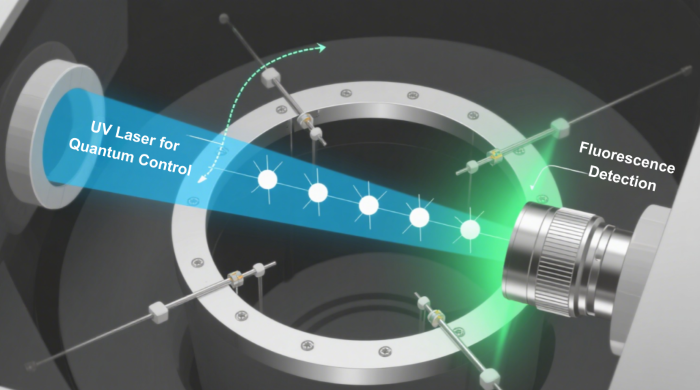
Schematic diagram of quantum capture. Image Credit: Avantier Inc.
Key Optical Criteria for Ion Capture
- Uniform Laser Distribution: Prevents errors in ion excitation intensity.
- High Fluorescence Collection Efficiency: Essential for capturing weak quantum state signals.
- Broad Field of View: Crucial for scaling multi-ion qubit arrays.
- Extended Working Distance: Prevents hardware interference while maintaining vacuum integrity.
Technical Benefits of LWD Microscope Objectives
- Long Working Distance: Millimeter-to-centimeter range, compared to less than 1 mm in standard objectives
- Wide Field Capability: Supports concurrent observation of multiple qubits
- High Resolution: Aberration-corrected optics provide diffraction-limited imaging
- Minimal Distortion: Guarantees precise laser focusing and qubit positioning
- Multi-Wavelength Performance: Chromatic aberration correction for UV laser and fluorescence
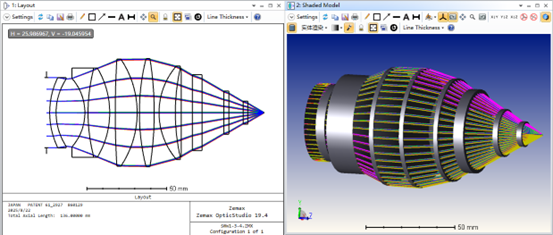
Long working distance microscope objective optical path diagram. Image Credit: Avantier Inc.
Case Study: Avantier’s Customized Long Working Distance UV Objective Lens
Client Objectives
A leading quantum computing research team needed a customized UV objective lens that could deliver:
- 1 µm laser spot projection precision for qubit control
- Distortion below 0.1 µm in the object plane
- High transmission (greater than 80 %) at 397-400 nm
- Dual functionality for both laser delivery and fluorescence imaging
Challenges Faced
- Distortion: Initial design exhibited approximately 2.6 µm distortion, exceeding tolerance.
- Thermal Sensitivity: A 16 µm focus shift between 20–25 °C necessitated mitigation.
- UV Testing Constraints: Direct MTF and wavefront error assessment at 397 nm was impractical.
First-Generation Lens Design
- Focal Length: 43.74 mm at 397 nm
- FOV: 300 µm × 40 µm
- Distortion: Less than 0.1 µm target (not consistently achieved)
- NA: 0.5 in vacuum
- Transmission: More than 85 %
- Working Distance: More than 50 mm
Result: Achieved diffraction-limited performance within a restricted field of view, but failed to fulfill scalability requirements.
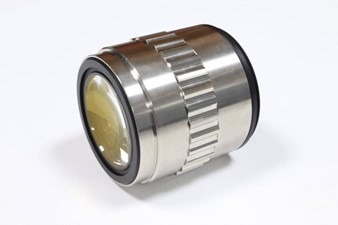
The first-generation lens. Image Credit: Avantier Inc.
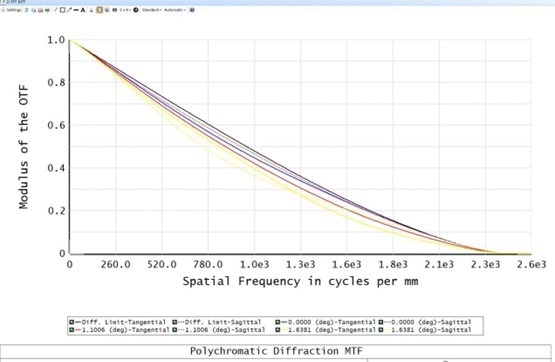
The MTF value of the first-generation lens. Image Credit: Avantier Inc.
Second-Generation Lens Design
To address the client’s expanded field-of-view and accuracy demands, Avantier introduced significant improvements:
- Dual-Window Assembly: Two-piece UV windows (6 mm + 3 mm) for stability
- Material Enhancement: Environmentally sustainable copper housing providing mechanical rigidity
- Cutting-edge Interferometry Calibration: Instantaneous tracking and active centering to reduce tilt and eccentricity
Performance Highlights
- FOV: 2.5 mm × 40 µm (eight times larger than earlier design)
- Distortion: Approximately 1 µm across the full field of view
- NA: 0.47 with high light collection efficiency
- Working Distance: 50 mm including window stack
- Wavefront Aberration: ≤0.07λ (central), ≤0.1λ (edge)
- Transmission: More than 80 % at UV wavelengths
- MTF: Diffraction-limited quality verified via 632.8 nm interferometry
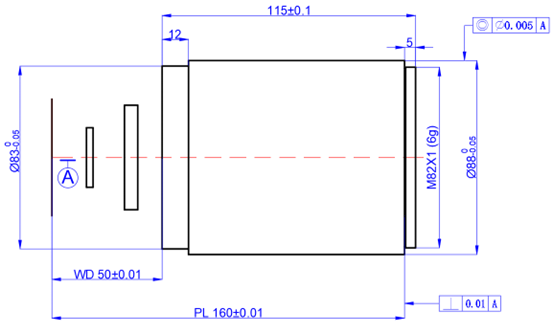
Second-generation lens exterior diagram. Image Credit: Avantier Inc.

MTF of the second-generation lens. Image Credit: Avantier Inc.

The second-generation lens. Image Credit: Avantier Inc.
Results and Effect on Quantum Computing
- Precision Spot Projection: Produced 1-1.2 µm Gaussian UV spots with less than 5 mrad telecentricity
- Fluorescence Imaging: Delivered a high-resolution, low-distortion readout of 397 nm ion emission
- Scalable Quantum Architectures: Broad FOV enabled multi-ion trapping and control
- Thermal and Mechanical Durability: Copper housing and stress-free mounting ensured long-term stability
- Optical R&D Development: Extended the limits of UV objective design, supporting quantum computing and broader applications, including optical lithography and semiconductor metrology.

Image Credit: Avantier Inc.
Advancing Ion Trap Studies with Tailored UV Objective Lens Designs
Long working distance microscope objectives are critical optical components supporting quantum computing technologies.
These tools drive advancement toward scalable qubit systems by providing high-resolution imaging and precision UV laser excitation within challenging ion-trap settings.
Avantier’s partnership proves how tailored UV objective design can address distortion, thermal, and field-of-view limitations, yielding diffraction-limited, high-transmission lenses optimized for ion-trapping applications.
For researchers furthering the development of quantum computing, photonics, and semiconductor metrology, customized LWD microscope objectives deliver the optical accuracy essential for unlocking the next generation of innovation.

This information has been sourced, reviewed and adapted from materials provided by Avantier Inc.
For more information on this source, please visit Avantier Inc.